Wenqi Fan
Rethinking Domain-Specific LLM Benchmark Construction: A Comprehensiveness-Compactness Approach
Aug 13, 2025Abstract:Numerous benchmarks have been built to evaluate the domain-specific abilities of large language models (LLMs), highlighting the need for effective and efficient benchmark construction. Existing domain-specific benchmarks primarily focus on the scaling law, relying on massive corpora for supervised fine-tuning or generating extensive question sets for broad coverage. However, the impact of corpus and question-answer (QA) set design on the precision and recall of domain-specific LLMs remains unexplored. In this paper, we address this gap and demonstrate that the scaling law is not always the optimal principle for benchmark construction in specific domains. Instead, we propose Comp-Comp, an iterative benchmarking framework based on a comprehensiveness-compactness principle. Here, comprehensiveness ensures semantic recall of the domain, while compactness enhances precision, guiding both corpus and QA set construction. To validate our framework, we conducted a case study in a well-renowned university, resulting in the creation of XUBench, a large-scale and comprehensive closed-domain benchmark. Although we use the academic domain as the case in this work, our Comp-Comp framework is designed to be extensible beyond academia, providing valuable insights for benchmark construction across various domains.
mKG-RAG: Multimodal Knowledge Graph-Enhanced RAG for Visual Question Answering
Aug 07, 2025Abstract:Recently, Retrieval-Augmented Generation (RAG) has been proposed to expand internal knowledge of Multimodal Large Language Models (MLLMs) by incorporating external knowledge databases into the generation process, which is widely used for knowledge-based Visual Question Answering (VQA) tasks. Despite impressive advancements, vanilla RAG-based VQA methods that rely on unstructured documents and overlook the structural relationships among knowledge elements frequently introduce irrelevant or misleading content, reducing answer accuracy and reliability. To overcome these challenges, a promising solution is to integrate multimodal knowledge graphs (KGs) into RAG-based VQA frameworks to enhance the generation by introducing structured multimodal knowledge. Therefore, in this paper, we propose a novel multimodal knowledge-augmented generation framework (mKG-RAG) based on multimodal KGs for knowledge-intensive VQA tasks. Specifically, our approach leverages MLLM-powered keyword extraction and vision-text matching to distill semantically consistent and modality-aligned entities/relationships from multimodal documents, constructing high-quality multimodal KGs as structured knowledge representations. In addition, a dual-stage retrieval strategy equipped with a question-aware multimodal retriever is introduced to improve retrieval efficiency while refining precision. Comprehensive experiments demonstrate that our approach significantly outperforms existing methods, setting a new state-of-the-art for knowledge-based VQA.
QA-Dragon: Query-Aware Dynamic RAG System for Knowledge-Intensive Visual Question Answering
Aug 07, 2025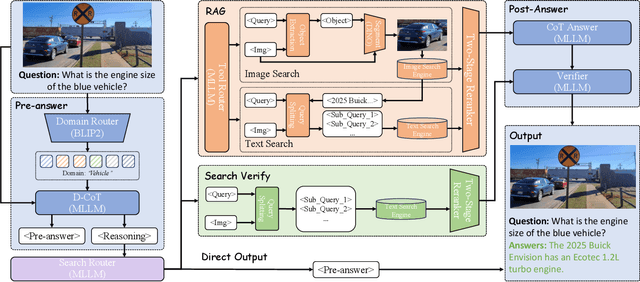

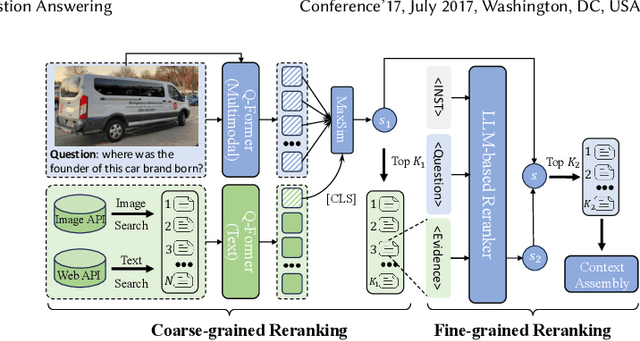

Abstract:Retrieval-Augmented Generation (RAG) has been introduced to mitigate hallucinations in Multimodal Large Language Models (MLLMs) by incorporating external knowledge into the generation process, and it has become a widely adopted approach for knowledge-intensive Visual Question Answering (VQA). However, existing RAG methods typically retrieve from either text or images in isolation, limiting their ability to address complex queries that require multi-hop reasoning or up-to-date factual knowledge. To address this limitation, we propose QA-Dragon, a Query-Aware Dynamic RAG System for Knowledge-Intensive VQA. Specifically, QA-Dragon introduces a domain router to identify the query's subject domain for domain-specific reasoning, along with a search router that dynamically selects optimal retrieval strategies. By orchestrating both text and image search agents in a hybrid setup, our system supports multimodal, multi-turn, and multi-hop reasoning, enabling it to tackle complex VQA tasks effectively. We evaluate our QA-Dragon on the Meta CRAG-MM Challenge at KDD Cup 2025, where it significantly enhances the reasoning performance of base models under challenging scenarios. Our framework achieves substantial improvements in both answer accuracy and knowledge overlap scores, outperforming baselines by 5.06% on the single-source task, 6.35% on the multi-source task, and 5.03% on the multi-turn task.
iTFKAN: Interpretable Time Series Forecasting with Kolmogorov-Arnold Network
Apr 23, 2025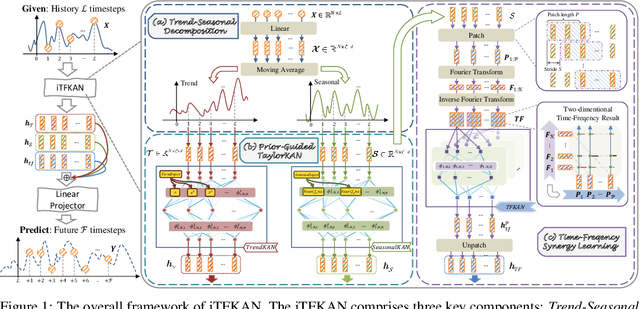



Abstract:As time evolves, data within specific domains exhibit predictability that motivates time series forecasting to predict future trends from historical data. However, current deep forecasting methods can achieve promising performance but generally lack interpretability, hindering trustworthiness and practical deployment in safety-critical applications such as auto-driving and healthcare. In this paper, we propose a novel interpretable model, iTFKAN, for credible time series forecasting. iTFKAN enables further exploration of model decision rationales and underlying data patterns due to its interpretability achieved through model symbolization. Besides, iTFKAN develops two strategies, prior knowledge injection, and time-frequency synergy learning, to effectively guide model learning under complex intertwined time series data. Extensive experimental results demonstrated that iTFKAN can achieve promising forecasting performance while simultaneously possessing high interpretive capabilities.
SemDiff: Generating Natural Unrestricted Adversarial Examples via Semantic Attributes Optimization in Diffusion Models
Apr 16, 2025Abstract:Unrestricted adversarial examples (UAEs), allow the attacker to create non-constrained adversarial examples without given clean samples, posing a severe threat to the safety of deep learning models. Recent works utilize diffusion models to generate UAEs. However, these UAEs often lack naturalness and imperceptibility due to simply optimizing in intermediate latent noises. In light of this, we propose SemDiff, a novel unrestricted adversarial attack that explores the semantic latent space of diffusion models for meaningful attributes, and devises a multi-attributes optimization approach to ensure attack success while maintaining the naturalness and imperceptibility of generated UAEs. We perform extensive experiments on four tasks on three high-resolution datasets, including CelebA-HQ, AFHQ and ImageNet. The results demonstrate that SemDiff outperforms state-of-the-art methods in terms of attack success rate and imperceptibility. The generated UAEs are natural and exhibit semantically meaningful changes, in accord with the attributes' weights. In addition, SemDiff is found capable of evading different defenses, which further validates its effectiveness and threatening.
Generative Recommendation with Continuous-Token Diffusion
Apr 16, 2025Abstract:In recent years, there has been a significant trend toward using large language model (LLM)-based recommender systems (RecSys). Current research primarily focuses on representing complex user-item interactions within a discrete space to align with the inherent discrete nature of language models. However, this approach faces limitations due to its discrete nature: (i) information is often compressed during discretization; (ii) the tokenization and generation for the vast number of users and items in real-world scenarios are constrained by a limited vocabulary. Embracing continuous data presents a promising alternative to enhance expressive capabilities, though this approach is still in its early stages. To address this gap, we propose a novel framework, DeftRec, which incorporates \textbf{de}noising di\textbf{f}fusion models to enable LLM-based RecSys to seamlessly support continuous \textbf{t}oken as input and target. First, we introduce a robust tokenizer with a masking operation and an additive K-way architecture to index users and items, capturing their complex collaborative relationships into continuous tokens. Crucially, we develop a denoising diffusion model to process user preferences within continuous domains by conditioning on reasoning content from pre-trained large language model. During the denoising process, we reformulate the objective to include negative interactions, building a comprehensive understanding of user preferences for effective and accurate recommendation generation. Finally, given a continuous token as output, recommendations can be easily generated through score-based retrieval. Extensive experiments demonstrate the effectiveness of the proposed methods, showing that DeftRec surpasses competitive benchmarks, including both traditional and emerging LLM-based RecSys.
Exploring Backdoor Attack and Defense for LLM-empowered Recommendations
Apr 15, 2025Abstract:The fusion of Large Language Models (LLMs) with recommender systems (RecSys) has dramatically advanced personalized recommendations and drawn extensive attention. Despite the impressive progress, the safety of LLM-based RecSys against backdoor attacks remains largely under-explored. In this paper, we raise a new problem: Can a backdoor with a specific trigger be injected into LLM-based Recsys, leading to the manipulation of the recommendation responses when the backdoor trigger is appended to an item's title? To investigate the vulnerabilities of LLM-based RecSys under backdoor attacks, we propose a new attack framework termed Backdoor Injection Poisoning for RecSys (BadRec). BadRec perturbs the items' titles with triggers and employs several fake users to interact with these items, effectively poisoning the training set and injecting backdoors into LLM-based RecSys. Comprehensive experiments reveal that poisoning just 1% of the training data with adversarial examples is sufficient to successfully implant backdoors, enabling manipulation of recommendations. To further mitigate such a security threat, we propose a universal defense strategy called Poison Scanner (P-Scanner). Specifically, we introduce an LLM-based poison scanner to detect the poisoned items by leveraging the powerful language understanding and rich knowledge of LLMs. A trigger augmentation agent is employed to generate diverse synthetic triggers to guide the poison scanner in learning domain-specific knowledge of the poisoned item detection task. Extensive experiments on three real-world datasets validate the effectiveness of the proposed P-Scanner.
CheatAgent: Attacking LLM-Empowered Recommender Systems via LLM Agent
Apr 13, 2025Abstract:Recently, Large Language Model (LLM)-empowered recommender systems (RecSys) have brought significant advances in personalized user experience and have attracted considerable attention. Despite the impressive progress, the research question regarding the safety vulnerability of LLM-empowered RecSys still remains largely under-investigated. Given the security and privacy concerns, it is more practical to focus on attacking the black-box RecSys, where attackers can only observe the system's inputs and outputs. However, traditional attack approaches employing reinforcement learning (RL) agents are not effective for attacking LLM-empowered RecSys due to the limited capabilities in processing complex textual inputs, planning, and reasoning. On the other hand, LLMs provide unprecedented opportunities to serve as attack agents to attack RecSys because of their impressive capability in simulating human-like decision-making processes. Therefore, in this paper, we propose a novel attack framework called CheatAgent by harnessing the human-like capabilities of LLMs, where an LLM-based agent is developed to attack LLM-Empowered RecSys. Specifically, our method first identifies the insertion position for maximum impact with minimal input modification. After that, the LLM agent is designed to generate adversarial perturbations to insert at target positions. To further improve the quality of generated perturbations, we utilize the prompt tuning technique to improve attacking strategies via feedback from the victim RecSys iteratively. Extensive experiments across three real-world datasets demonstrate the effectiveness of our proposed attacking method.
Investigating and Mitigating Stereotype-aware Unfairness in LLM-based Recommendations
Apr 05, 2025Abstract:Large Language Models (LLMs) have demonstrated unprecedented language understanding and reasoning capabilities to capture diverse user preferences and advance personalized recommendations. Despite the growing interest in LLM-based personalized recommendations, unique challenges are brought to the trustworthiness of LLM-based recommender systems (LLM-RS), since LLMs are likely to inherit stereotypes that are embedded ubiquitously in word embeddings due to their training on large-scale uncurated datasets. This leads to LLM-RS exhibiting stereotypical linguistic associations between users and items. However, there remains a lack of studies investigating the simultaneous existence of stereotypes between users and items in LLM-RS. To bridge this gap, this study reveals a new variant of fairness between stereotype groups containing both users and items, to quantify discrimination against stereotypes in LLM-RS. Moreover, in this paper, to mitigate stereotype-aware unfairness in textual user and item information, we propose a novel framework (MoS), in which an insightful stereotype-wise routing strategy over multiple stereotype-relevant experts is designed to learn unbiased representations against different stereotypes in LLM- RS. Extensive experiments are conducted to analyze the influence of stereotype-aware fairness in LLM-RS and the effectiveness of our proposed methods, which consistently outperform competitive benchmarks under various fairness settings.
Retrieval-Augmented Purifier for Robust LLM-Empowered Recommendation
Apr 03, 2025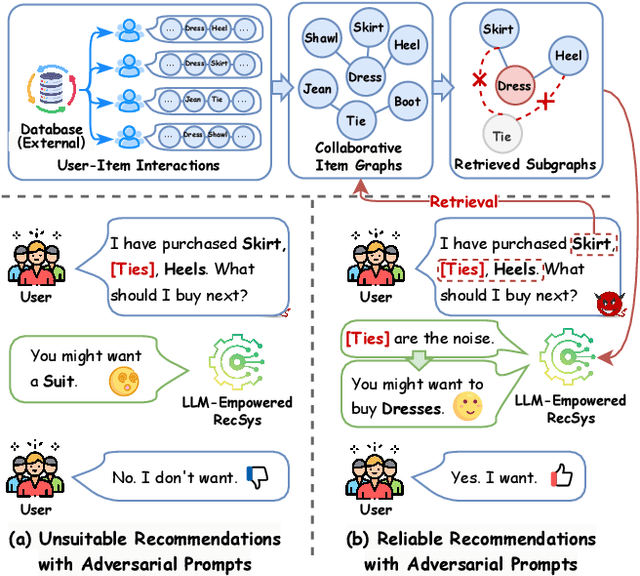
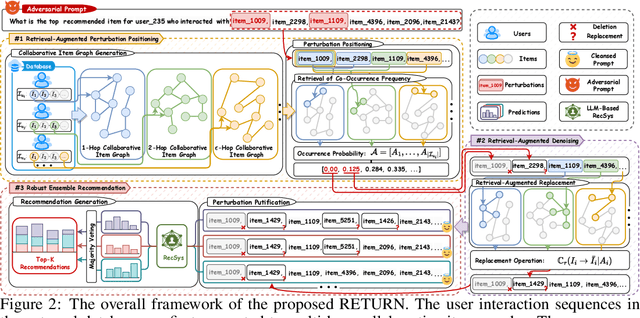
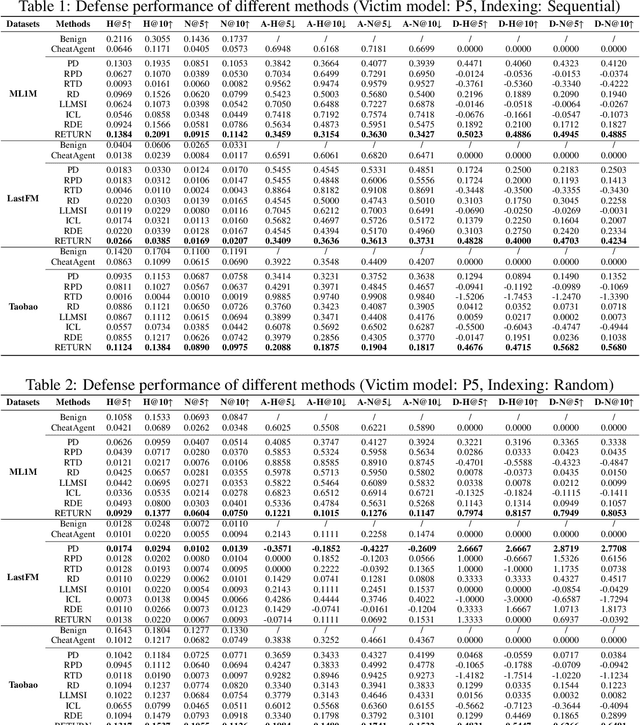

Abstract:Recently, Large Language Model (LLM)-empowered recommender systems have revolutionized personalized recommendation frameworks and attracted extensive attention. Despite the remarkable success, existing LLM-empowered RecSys have been demonstrated to be highly vulnerable to minor perturbations. To mitigate the negative impact of such vulnerabilities, one potential solution is to employ collaborative signals based on item-item co-occurrence to purify the malicious collaborative knowledge from the user's historical interactions inserted by attackers. On the other hand, due to the capabilities to expand insufficient internal knowledge of LLMs, Retrieval-Augmented Generation (RAG) techniques provide unprecedented opportunities to enhance the robustness of LLM-empowered recommender systems by introducing external collaborative knowledge. Therefore, in this paper, we propose a novel framework (RETURN) by retrieving external collaborative signals to purify the poisoned user profiles and enhance the robustness of LLM-empowered RecSys in a plug-and-play manner. Specifically, retrieval-augmented perturbation positioning is proposed to identify potential perturbations within the users' historical sequences by retrieving external knowledge from collaborative item graphs. After that, we further retrieve the collaborative knowledge to cleanse the perturbations by using either deletion or replacement strategies and introduce a robust ensemble recommendation strategy to generate final robust predictions. Extensive experiments on three real-world datasets demonstrate the effectiveness of the proposed RETURN.
 Add to Chrome
Add to Chrome Add to Firefox
Add to Firefox Add to Edge
Add to Edge